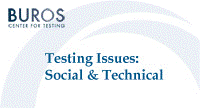Buros-Nebraska Series on Measurement and Testing

Social and Technical Issues in Testing: Implications for Test Construction and Usage
Date of this Version
1984
Document Type
Article
Citation
Published in Social and Technical Issues in Testing: Implications for Test Construction and Usage, edited by Barbara S. Plake (Hillsdale, NJ: Lawrence Erlbaum Associates, 1984).
Abstract
Why do we have tests? What useful purposes do they serve? How can test results be used to make decisions? How can a test be proved to provide accurate and usable information? Questions such as these have been posed recently by a concerned public who have become more aware of and concerned about testing, test quality, and appropriate test usage. Their questions are challenging, legitimate queries that can and should be addressed by members of the measurement community .
Some of the questions being asked by the public are value laden, providing topics for many thoughtful but heated debates. For example: Would we be better off as a society if we did not have tests? Should testing be banned? Other questions are technical in nature and require accurate answers from the measurement community, which communicates to the public the present state of the art in measurement, assessment, and interpretation. Finally, questions such as "How can tests be used to eliminate the errors made in the selection process?" can provide an impetus within the measurement field for both theoretical and empirical development and yet are not ones that can, at least so far, be definitely answered .
The measurement field should take serious stock of itself and assess, as well as possible, the boundaries of its capabilities. From this assessment, it would be possible to communicate with the public about what testing can do, may be able to do, and is incapable of ever doing. At the present time, however, there appears to be an informational and expectational gap concerning what can be possible with the use of test results. Unless measurement experts and test users obtain a direct line to the angels, for example, error-free measurement will never be a reality!
Part of the communication and expectation gap can be assigned to a lack of measurement sophistication on the part of the public. Measurement course work and classes are not readily accessible to the public as a whole and may not be truly meaningful and usable to the public even if they were . A well-meaning but confused public provides fertile ground for test misunderstanding and misrepresentation by both knowledgeable and unknowledgeable test representatives. Tests enter into the lives of the public in so many ways; questionnaires, market surveys, school achievement batteries, classroom exams, and admission screenings are only a few possibilities. Yet the knowledge level of the public is minimal at best with regard to test information and interpretation.


Comments
Copyright © 1984 by Lawrence Erlbaum Associates. Digital edition copyright © 2012 Buros Center for Testing. This book may be downloaded, saved, and printed by an individual for their own use. No part of this book may be re-published, re-posted, or redistributed without written permission of the holder of copyright.